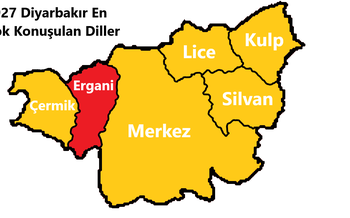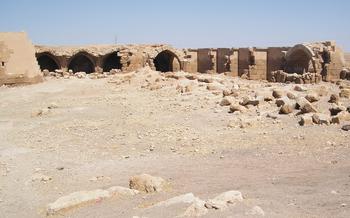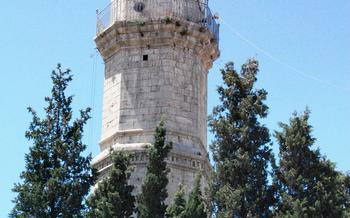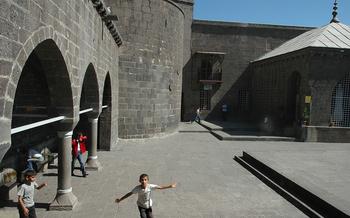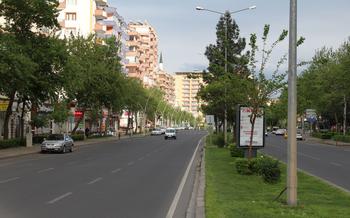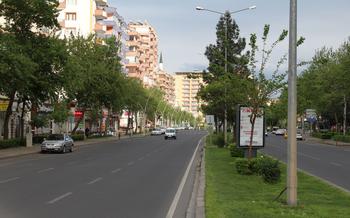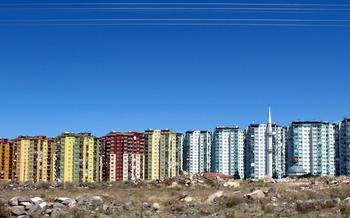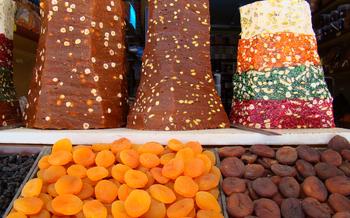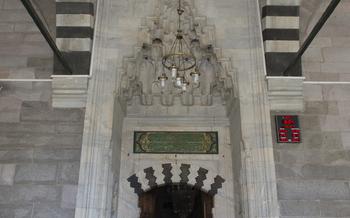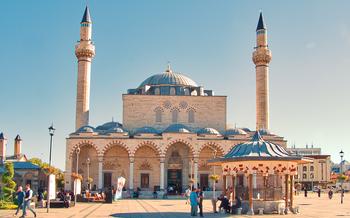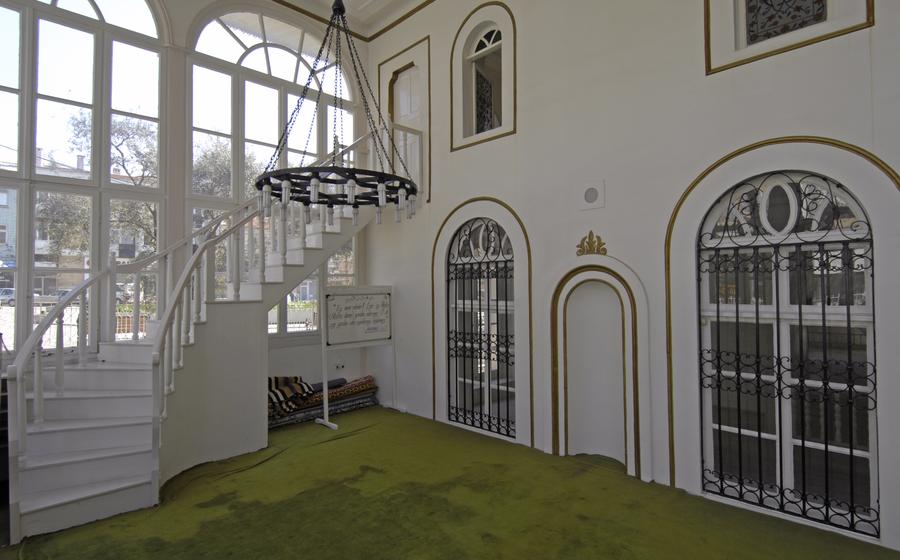
Kurşunlu Mosque
- Kurşunlu Mosque: A Timeless Masterpiece
- Captivating Courtyards: A Haven of Tranquility
- Minaret's Majesty: A Beacon of Faith
- Prayer Hall's Grandeur: A Space for Worship
- Historical Context: A Journey Through Time
- Cultural Heritage: A Tapestry of Traditions
- Architectural Marvels: A Fusion of Styles
- Symbol of Resilience: Enduring Through Time
- Local Traditions: A Glimpse into Daily Life
- Pilgrimage and Devotion: A Sacred Destination
- Inspiring Restoration: Preserving a Legacy
- Educational Center: A Place of Knowledge
- Discover Local Craftsmanship: A Touch of Authenticity
- Community Gatherings: A Place for Connection
- Insider Tip: Capture the Magic of Dawn
Kurşunlu Mosque: A Timeless Masterpiece
The Kurşunlu Mosque stands as a timeless masterpiece, a testament to the rich history and architectural prowess of Diyarbakır. Built in the 16th century under the reign of the Ottoman Sultan Süleyman the Magnificent, the mosque embodies the essence of Islamic architecture, blending intricate designs, elegant proportions, and spiritual symbolism. Its name, "Kurşunlu," translates to "leaded," a reference to the lead-covered domes that crown the mosque, shimmering in the sunlight and adding a touch of grandeur to the cityscape.
Captivating Courtyards: A Haven of Tranquility
As you enter the sacred grounds of the Kurşunlu Mosque, your senses will be captivated by the serenity of its courtyards. These tranquil spaces, adorned with lush greenery and the gentle murmur of water, offer a respite from the bustling city outside.
The courtyards, designed with meticulous attention to detail, are an integral part of the mosque's architectural design. They provide a harmonious transition between the exterior and interior spaces, creating a gradual sense of tranquility as you approach the prayer hall.
Water elements, a recurring theme in Islamic architecture, are prominently featured in the courtyards. Intricate fountains, with their soothing sounds and shimmering reflections, add to the serene ambiance. The rhythmic flow of water symbolizes purity, cleansing, and the continuous remembrance of God.
The courtyards are not merely decorative spaces; they serve a functional purpose as well. They provide ample space for ablutions, the ritual purification performed before prayer. The ablution fountains, with their multiple taps, allow worshippers to perform their ablutions in a convenient and orderly manner.
Beyond their practical function, the courtyards create a serene and contemplative atmosphere that prepares the heart and mind for worship. The lush gardens, with their vibrant flowers and aromatic plants, contribute to the overall ambiance, creating a sanctuary of peace and tranquility.
As you wander through the courtyards, take a moment to pause and appreciate the intricate tilework and calligraphy adorning the walls. These decorative elements, often featuring verses from the Quran, add to the spiritual aura of the space.
Whether you are seeking a moment of solitude or simply marveling at the architectural beauty, the courtyards of the Kurşunlu Mosque offer a sanctuary of peace and tranquility, inviting you to immerse yourself in the serenity of this sacred space.
Minaret's Majesty: A Beacon of Faith
The Kurşunlu Mosque's minaret stands tall, a majestic symbol of faith and devotion. Its elegant cylindrical form soars towards the heavens, adorned with intricate carvings and decorative bands. The minaret's slender silhouette is a distinctive feature of the mosque, visible from afar. It serves as a beacon, guiding the faithful to the house of worship and calling them to prayer with its melodious summons.
In Islamic architecture, minarets hold great significance. They are not merely structural elements but powerful symbols of faith and religious identity. The minaret of the Kurşunlu Mosque embodies this symbolism, representing the connection between heaven and earth, the divine and the earthly. It is a reminder of the presence of God, inviting the faithful to turn their hearts and minds towards the Almighty.
The call to prayer, known as the adhan, is a crucial aspect of Islamic worship. The muezzin, or caller to prayer, ascends the minaret five times a day to deliver the adhan. Their resonant voices echo through the city, inviting the faithful to join in prayer and unite in worship. The minaret, therefore, serves as a symbol of unity and community, calling upon the believers to come together and fulfill their religious obligations.
Prayer Hall's Grandeur: A Space for Worship
Step inside the prayer hall of the Kurşunlu Mosque, and be enveloped by a sense of awe and serenity. The vast interior is a testament to the grandeur of Islamic architecture, with intricate decorations and ornamental elements that adorn every surface. The walls are adorned with vibrant tiles, each one meticulously crafted and arranged to form mesmerizing patterns. Verses from the Quran are inscribed in elegant calligraphy, adding to the spiritual aura of the space. The high ceiling is supported by a forest of slender columns, their capitals elaborately carved with geometric designs. The overall effect is one of opulence and splendor, creating a fitting environment for prayer and contemplation. The prayer hall's serene ambiance invites the faithful to immerse themselves in devotion, surrounded by the beauty of Islamic art and architecture.
Historical Context: A Journey Through Time
Diyarbakır, a city steeped in history and cultural heritage, serves as the backdrop for the Kurşunlu Mosque's existence. The mosque's history is intertwined with the city's rich past, reflecting the diverse civilizations that have left their mark on this region.
Diyarbakır, strategically located on the Silk Road, has been a melting pot of cultures throughout history. From the ancient Assyrians and Romans to the Byzantines and Seljuks, each civilization has contributed to the city's architectural and cultural tapestry. The Kurşunlu Mosque, built in the 16th century, stands as a testament to the city's continuous transformation and rich heritage.
As a major center of Islamic learning and culture, Diyarbakır has long been a pilgrimage site for Muslims worldwide. The city's numerous mosques, including the Kurşunlu Mosque, have played a crucial role in fostering religious devotion and preserving Islamic traditions. The mosque's historical significance lies in its embodiment of Diyarbakır's enduring spirit and its ability to bridge the gap between the past and the present.
Cultural Heritage: A Tapestry of Traditions
The Kurşunlu Mosque fusion of Islamic, Seljuk, and Ottoman architectural styles, the mosque embodies the city's diverse past. The intricate tilework, calligraphy, and decorative elements showcase the skill and artistry of local craftsmen. The mosque's unique blend of architectural influences reflects Diyarbakır's position as a crossroads of civilizations, where different cultures have intersected and left their mark.
As a cultural symbol, the Kurşunlu Mosque represents the deep-rooted Islamic traditions of the region. Its architectural features, such as the pointed arches and domes, the minaret, and the prayer hall's layout, embody the essence of Islamic architecture. The mosque's symbolic significance extends beyond its religious function, as it serves as a gathering place for the community, a center for education, and a symbol of Diyarbakır's cultural identity.
Architectural Marvels: A Fusion of Styles
The Kurşunlu Mosque stands as a testament to the harmonious blend of architectural styles that have shaped Turkey's rich heritage. The mosque's design reflects a fusion of Islamic, Seljuk, and Ottoman influences, creating a unique and captivating architectural masterpiece.
The mosque's Seljuk roots are evident in its pointed arches and intricate stone carvings, which adorn the portals and windows. These decorative elements showcase the Seljuk mastery of stonework, creating a sense of grandeur and elegance.
The Ottoman influence is visible in the mosque's expansive dome, which crowns the prayer hall. The dome's intricate patterns and vibrant colors are a hallmark of Ottoman architecture, adding a touch of grandeur and opulence to the mosque's interior.
The fusion of Islamic, Seljuk, and Ottoman styles in the Kurşunlu Mosque creates a harmonious and visually stunning architectural ensemble. This blend of influences reflects the mosque's position as a crossroads of cultures and civilizations, making it a significant landmark in Turkey's architectural history.
Symbol of Resilience: Enduring Through Time
The Kurşunlu Mosque has stood the test of time, enduring various challenges that could have compromised its existence. Throughout the centuries, it has undergone several restoration efforts to preserve its architectural integrity and maintain its religious significance. The resilience of the mosque serves as a symbol of faith and perseverance, a testament to the dedication of the community to protect and preserve this cherished landmark.
In the face of natural disasters, such as earthquakes, and the wear and tear of time, the mosque has remained steadfast. Its solid foundation and robust construction have allowed it to withstand these challenges without significant damage. The restoration initiatives undertaken by the government, in collaboration with local communities, have played a crucial role in ensuring that the mosque's unique architectural features and historical value are preserved for future generations.
The Kurşunlu Mosque's ability to endure through time is a testament to the enduring power of faith and the dedication of the community to protect and preserve their cultural and religious heritage. It stands as a symbol of resilience, reminding visitors of the importance of preserving history and promoting understanding and tolerance among people of different faiths.
Local Traditions: A Glimpse into Daily Life
The Kurşunlu Mosque is not merely a religious edifice; it is also an integral part of the local community, deeply intertwined with the cultural fabric of Diyarbakır. Over the centuries, the mosque has become a focal point for various traditions and practices that reflect the city's rich heritage.
During the holy month of Ramadan, the mosque transforms into a vibrant hub of activity. The courtyard fills with people breaking their fast, sharing meals, and engaging in communal prayers. The mosque also hosts special events and celebrations throughout the year, such as religious festivals and weddings.
Beyond religious observances, the mosque serves as a gathering place for the community. Locals often visit the mosque to socialize, exchange stories, and seek guidance from religious leaders. The mosque's courtyard is a place for people to connect, share experiences, and strengthen their bonds.
One of the most significant local traditions associated with the Kurşunlu Mosque is the annual Mevlid-i Nebi celebration, which commemorates the birth of the Prophet Muhammad. During this festival, the mosque is adorned with colorful decorations, and special prayers and recitations are held. The city comes alive with festivities, and the mosque becomes a central point for the community to celebrate and rejoice together.
Pilgrimage and Devotion: A Sacred Destination
The Kurşunlu Mosque holds immense religious significance for Muslims worldwide, attracting pilgrims and devotees seeking a spiritual connection with the divine. As a sacred destination, the mosque serves as a place of worship, contemplation, and spiritual renewal. The mosque's serene atmosphere and rich history create an environment conducive to deep reflection and communion with God. Pilgrims from near and far flock to the mosque to offer prayers, perform religious rituals, and seek blessings. The mosque's spiritual aura and the opportunity to connect with fellow believers make it a cherished destination for those seeking a profound religious experience.
Inspiring Restoration: Preserving a Legacy
The Kurşunlu Mosque's restoration journey stands as a testament to the resilience and dedication of the local community and the Turkish government. Recognizing the mosque's historical and cultural significance, extensive efforts were undertaken to restore its grandeur. The restoration process involved meticulous attention to detail, ensuring that the mosque's original architectural features were preserved while addressing structural issues. The collaboration between experts, architects, and craftsmen was instrumental in bringing the mosque back to its former glory. The successful restoration of the Kurşunlu Mosque serves as an inspiration, demonstrating the importance of preserving historical landmarks and safeguarding cultural heritage for future generations.
Educational Center: A Place of Knowledge
The Kurşunlu Mosque has a long-standing tradition of fostering knowledge and learning. It houses a historical madrasah, an Islamic educational institution that played a pivotal role in educating students in religious and secular subjects. The madrasah was renowned for its distinguished scholars and the quality of education it provided. Students from various parts of the region flocked to the mosque to benefit from the teachings of renowned Islamic scholars and intellectuals.
The mosque's educational legacy continues to this day, as it serves as a center for religious and cultural studies. Regular classes, lectures, and workshops are held at the mosque, covering various aspects of Islamic theology, history, and culture. The mosque's rich collection of books, manuscripts, and artifacts also serves as a valuable resource for researchers and scholars. By preserving and promoting Islamic knowledge, the Kurşunlu Mosque plays a crucial role in nurturing the intellectual and spiritual development of the community.
Discover Local Craftsmanship: A Touch of Authenticity
The Kurşunlu Mosque is a testament to the exquisite craftsmanship and artistry that flourished in Diyarbakır. Its intricate tilework, intricate carvings, and decorative elements showcase the skills and dedication of local artisans. The mosque's interior is adorned with colorful tiles, each hand-painted with intricate designs and patterns. These tiles depict scenes from Islamic history, geometric motifs, and verses from the Quran, adding a touch of spirituality and beauty to the space.
The mosque's minaret is another masterpiece of craftsmanship, featuring intricate brickwork and decorative bands. The intricate tilework on the minaret's exterior is particularly striking, showcasing the intricate patterns and vibrant colors characteristic of Diyarbakır's architectural heritage. The mosque's courtyard also features a beautiful fountain, adorned with intricate carvings and tilework. The fountain's water cascades into a pool, creating a soothing ambiance and adding to the overall tranquility of the space.
Preserving this rich tradition of craftsmanship is crucial to maintaining Diyarbakır's cultural heritage. The mosque's restoration efforts have placed a strong emphasis on preserving the original craftsmanship and techniques used in its construction. By supporting local artisans and craftsmen, visitors can contribute to the preservation of this valuable cultural heritage and ensure that future generations can continue to appreciate the beauty and artistry of the Kurşunlu Mosque.
Community Gatherings: A Place for Connection
The Kurşunlu Mosque is not merely a religious edifice; it is also a vibrant social hub that fosters a sense of community and togetherness. Throughout history, the mosque has played a pivotal role in bringing people together for various events and celebrations. Muslims from all walks of life congregate within its sacred walls to celebrate religious festivals, share joyous occasions, and extend support during times of need. The mosque's spacious courtyards and inviting atmosphere provide an ideal setting for community gatherings, where bonds are strengthened, and traditions are passed down from generation to generation. Whether it's a religious ceremony, a wedding celebration, or a community feast, the Kurşunlu Mosque stands as a testament to the power of faith and the enduring spirit of community.
Insider Tip: Capture the Magic of Dawn
The Kurşunlu Mosque unveils a captivating charm in the ethereal light of dawn. As the city awakens, the mosque radiates a serene aura, casting long shadows that accentuate its architectural grandeur. With fewer crowds at this tranquil hour, you can immerse yourself in the mosque's beauty without distractions. Capture the essence of the mosque in photographs that encapsulate its majesty. The soft glow of the rising sun illuminates the intricate details of the facade, creating a magical ambiance that will leave an indelible mark on your memory. Embrace the tranquility of the early morning and let the mosque's timeless allure transport you to a realm of serenity and inspiration.
